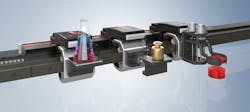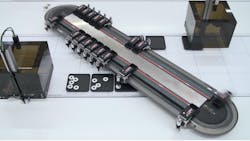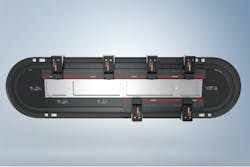Beckhoff Updates XTS with No-Cable Technology
Beckhoff’s eXtended Transport System (XTS) features movers that can move independently or be synchronized in groups for material handling in a variety of applications, such as CPG (consumer packaged goods) packaging applications. The XTS features built-in collision avoidance and tooling on the XTS movers that can be used to open and close bags, cap bottles, or move parts down the line.
Jeff Johnson, mechatronics product manager at Beckhoff Automation, said, “XTS is not just a substitute for lower-cost solutions like chain-driven systems with lugs and buckets, it’s a fundamentally different way to approach material handling transport processes.”
The addition of NCT to XTS means that processing steps and quality control can be accomplished directly on the mover while a process is running.
“Traditionally on linear transport systems, if you wanted to grip something you'd have to have two movers mechanically linked to do the gripping,” explained Johnson. “Now that we’ve integrated power and data on the movers, you can mount things like vacuum generators on the movers to do vacuum pickup of materials. You can even use mechanical actuators—really any end of arm robot tooling can be mounted on the movers to pick and place product.”
A few XTS with NTC application examples include the ability to:
- divide and reunite product flows using mechatronic transfers between two movers;
- sort products using an integrated pusher on the mover;
- pick and place products for product sorting using vacuum suction units; and
- pick up individual products from unsorted and irregular product flows and be able to sort them into good and bad parts or place them correctly for final packaging.
System control and communications
Using the TwinCAT control system for power and communication makes connection of sensors and actuators easy, according to Beckhoff. Because data communication with each mover is real-time capable, EtherCAT can synchronize system-wide events with micro-second precision so that a specific event can be triggered at an exact position—a key requirement in high-speed packaging and processing operations.
Throughput can be increased by adding movers. Beckhoff notes that each mover can perform multi-axis movements, allowing for product alignment in the X, Y, and Z directions. Additional degrees of freedom can be achieved by rotary movements using TwinCAT to control the interaction of the axes via CNC functions. Johnson said this integration turns XTS into a flexible multi-robot system that increases sorting performance while reducing the required installation space.
About the Author
David Greenfield, editor in chief
Editor in Chief

Leaders relevant to this article:


